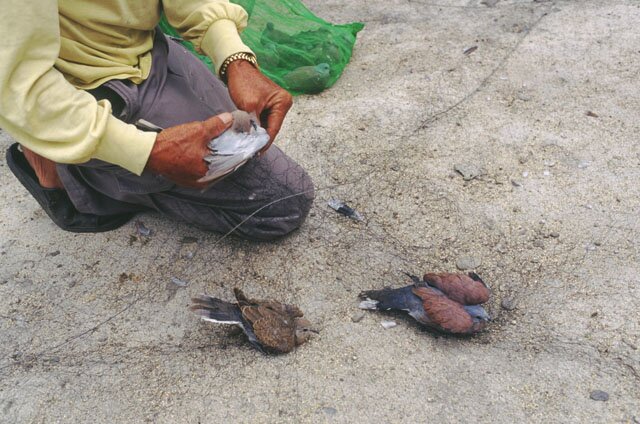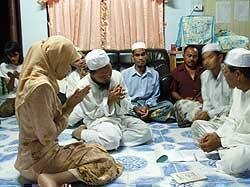BROWSE COUNTRIES/ TERRITORIES
Bruce Lee's Enduring Appeal
Gongfu fans still can’t get enough of Bruce Lee whose legend grows with help from David Bowie, David Henry Hwang and Wu Ziniu.
Picked over Gandhi and Pope John Paul II as a symbol of solidarity, a statue of Bruce Lee was erected last November in Mostar, a southern city of Bosnia-Herzegovina. Life-sized (5 ft 7 inch, 168 cm) and in shining bronze, the legendary martial artist and movie superstar stood tall in Central Park, just off the front line where Bosnian Croats and Muslims had killed each other indiscriminately for three bloody years from 1992 to 1995. A decade after the United Nations imposed a ceasefire, Mostar’s ethnic groups remain deeply divided. Its city fathers hoped that the presence of Bruce Lee would help to lend stability to the uneasy peace. The statue was put up with the help of China and Germany, whose ambassadors were present at its unveiling.
Too far-fetched to have Bruce Lee, dead these 33 years, to do peacekeeping duty in a war-torn East European country he had never visited? Not to the Bosnians. Bruce Lee movies are popular in Mostar. Its people remain impressed by his fighting skill and his determination to triumph against all odds. Admiration of Bruce Lee is one of few things shared by the Croats and Muslims.
Bosnians are hardly alone in their Bruce Lee craze. The man may have died in 1973, but his legacy lives on. In the first years of the 21th century, the Cult of the Dragon—so called as Bruce Lee’s screen name was Hsiao Lung (Little Dragon)—is bigger than before. Bruce Lee has become an icon that transcends cultural and national boundaries. Like Elvis, Mohamad Ali, Nelson Mandela and Che Guevara, he has followers all over the world. Like the people in Mostar, they have taken him as one of their own. The fact that he is Chinese is as immaterial to his admirers as that Ali and Elvis are American, Mandela is South African and Che is Cuban.
Bruce Lee stamps have been issued by three African countries —Gambia, Tanzania and the Central African Republic— and by tiny Antigua-Barbuda, a Caribbean tax and online gambling haven with a population of 64,000. In 2002, the government of Myanmar sent out a stern warning that a set of Bruce Lee stamps bearing the words ‘Union of Myanmar’ was a fake. It immediately became a collector’s item.
Bruce Lee T-shirts, mugs and key chains are on sale everywhere. So is the weapon called the nanchuku (two short sticks connected by a length of chain), which he made famous in his movies. (The Mostar statue carries a nanchuku in its right hand). Books and magazines on Bruce Lee proliferate, enough to fill up an entire aisle of a large bookstore. Amazon alone has 441 Bruce Lee titles on offer.
The Japanese put Bruce Lee in manga (comics) and anime (cartoons). Microsoft digitized him into its X-Box games. Madam Tussaud’s cast him in wax and put him on display in its museum in Shanghai. The Bruce Lee Club of Hong Kong, one of the many in the world, raised US$150,000 and put up a statue, also in bronze but much larger at 2.5 m, facing Victoria Harbour. It was crafted by Cao Chongen, known throughout China as “Deng Xiaoping’s sculptor”. The statue was unveiled a day after the one in Mostar, on November 27, 2005. It would have been Bruce Lee’s 65th birthday. Robert, his younger brother, a musician and businessman, did the unveiling.
(Bruce Lee, who has German blood from his mother’s side of the family, was related to the illustrious Hotung clan in Hong Kong and Stanley Ho, the casino king of Macau. But his mother was estranged from her family and he never acknowledged them. Bruce Lee’s American widow, Linda Emery, has remarried. His son Brandon, also a martial arts actor, died in 1993 at the age 28 after being shot with a ‘prop’ gun while shooting the ‘cursed’ movie, The Crow. His daughter Shannon, an actress and musician, lives in California, is married and runs the Bruce Lee Foundation to promote martial arts. Bruce Lee is buried in Seattle, where he met Linda while studying philosophy at the University of Washington.
In America, a Bruce Lee musical is winding its way to a Broadway opening in 2008. Variety, the indispensable gossip rag of the entertainment trade, says a trio of heavyweights are working on it: the ever youthful David Bowie will write the score, David Henry Hwang, the Chinese-American award winning playwright (M Butterfly) will do the script and Matthew Warchus, last seen on Broadway directing the Lord of the Rings musical, will be its director.
Over in China, the Bruce Lee industry is thriving. There are Bruce Lee stamps, Bruce Lee books and magazines, Bruce Lee photographs and various Bruce Lee weaponry (all illegal but easily obtainable.) There is even a Bruce Lee museum, set up in 2002 in his ancestral home of Shunde in the Guangdong province, never mind that Bruce Lee visited the place only once, when he was five.
This year, Beijing put the official stamp of approval on one of its proudest sons. China’s rulers have given permission to the state-owned China International Television Corporation to fund a 40-episode TV drama on Bruce Lee. It will be directed by Wu Ziniu, whose 1986 war film, Evening Bell, won the Special Jury Award at the Berlin Film Festival. The drama will be aired in 2008, to coincide with China hosting the Olympics. CITC also intends to market the series to overseas buyers, the first time it has ever done so.
In virtual reality, Bruce Lee is every bit as popular as he is in the real world, perhaps even more so. Unencumbered by space and distance, Internet shrines of the master have mushroomed to uncounted numbers. Some are simply fan sites where his admirers gather. One of them, Bruce Lee Café Plus of South Korea, has attracted 18,000 members since it was set up in 2004.
There are many ‘specialty sites’ focusing on just one aspect of Bruce Lee’s life or his art. Some are dedicated to examining his quotes. (A famous Bruce Lee quote sounds like it comes straight out of the pages of Malcolm Gladwell’s best-selling self-help book, Blink. It goes like this: “Don’t think, feel. It’s like pointing a finger away to the moon. Don’t concentrate on the finger, or you will miss all the heavenly glory.” Could Gladwell be a Bruce Lee fan?)
Some sites examine Bruce Lee’s movie fighting scenes in minute detail. They also play out the scenes in real time. Bruce Lee, unlike other gongfu stars, never employed camera tricks. Every scene was done raw— no wires, no props, nothing. The only ‘trick’ he adopted was to slow down the camera so the audience could see his moves. Initially, in the editing room, all one saw were opponents just falling—Bruce Lee’s arms and feet were moving too fast to be seen.

A wax figure of Bruce Lee at Madame Tussauds
Like John F Kennedy and Martin Luther King Junior, Bruce Lee also has many Internet sites expounding various conspiracy theories relating to his death. Bruce Lee died on July 20, 1973, in the Hong Kong apartment of his co-star, the actress Betty Ting Pei. He had complained about a headache. Ting Pei gave him the painkiller Equagesic, prescribed to her by her doctor. He went off to take a nap on her bed, and never woke up.
That, at least, was the semi-official version of his death. There is no official version. The coroner’s verdict was ‘death by misadventure’. There were talks of traces of cannabis in his blood. There were also rumours that Ting Pei, widely believed to be his lover, gave him an aphrodisiac that went wrong. Some think she murdered him, or at least was an accomplice to his murder. The murderers were said to be rival martial artists, rival filmmakers of his studio, Golden Harvest, gangsters or drug lords. Ting Pei, who went on to make more movies, marry and have a daughter, has never said much about Bruce Lee except, “I would never have harmed him”.
Bruce Lee may have died of a drug overdose. If he did, it may be related to his martial arts training. Calling him a martial arts fanatic would be an understatement. Bruce Lee trained obsessively—he ran ‘only’ 16 km on days he wanted to relax – and was said to have used drugs to enhance his physique. He did complain about an incessant headache two months before he died. It could have been caused by drug abuse.
Whatever the cause of his death, Bruce Lee had done much to promote martial arts. He had opened Western eyes to its possibilities.
In the pre-Bruce Lee days, knowledge of martial arts in the West was rudimentary. They were pretty much limited to an esoteric circle of practitioners who learnt about it from GIs who discovered karate while assigned to Japan as part of the post WW2 occupying force. Migrant Chinese brought much of the art, especially those from Shaolin temples, to America. But the traditionally secretive Chinese kept it to themselves.
As a result, Asians in the West were always seen as emasculated, subservient and silly. The stereotyping was strongest in the image factories of Hollywood. It created a glass ceiling that prevented Asian performers, no matter how talented they might be, from getting top billing. In the first half of the 20th century, a pair of American-born Chinese, cousins, made their mark in Hollywood. James Wong Howe, a great cinematographer, was widely praised and was given an Oscar. He was the first Chinese to receive one. Anna May Wong, who acted with just about all the big names in her day, was always relegated to the role of a Chinese vamp. She died frustrated while her cousin retired in glory. The difference in their fortune could be traced to the fact that James Wong Howe operated behind the camera, and Anna May Wong in front of it.
Then Bruce Lee appeared, and he made it a point to change Americans’ perception of the Chinese. Cast as a sidekick to the masked adventurer Green Hornet in the 1966 TV series, Bruce Lee found that he had to play the role of a mindless Chinaman, much like Tonto to Lone Ranger. He refused, and made Kato a flesh-and-blood character. In an episode of the 1960s TV series Batman, he was to be beaten by the wimpish Robin. He prevailed on the director to change the script so he could win the fight.
Bit by bit, his martial artistry was recognised as a factor to be included in TV series and the movies. In Marlowe (1969), Bruce Lee appeared as a thug in the office of Philip Marlowe (James Garner) to warn the private eye off a sensitive case. Bowing from the waist, he straightened up, jumped on the spot, and smashed a lamp hanging on top of his head to smithereens with a vertical flying kick. It was one of the most memorable scenes of the movie.
Despite this, the Hollywood prejudice against the Chinese continued to work against him. In the late 1960s, Bruce Lee conceived a TV series about a martial arts student sent by his master into the world to do good. It eventually evolved into the hugely popular drama, Kung Fu. But Bruce Lee was denied the title role because “you look too Chinese”. It was given to David Carradine. A dejected Bruce Lee packed his bag for Hong Kong where he was given the offer to act in a low-budget flick called The Big Boss. The rest is history.

Bruce Lee, one of the 100 Most Influential People of the 20th Century (Time Magazine)
Bruce Lee found his ideal medium on the big screen. Freed from western preconceptions, he was able to perform the way he had always wanted. In five movies he opened the eyes of the multitude to the extraordinary effectiveness, beauty and power of gongfu. The impact was nothing short of earthshattering. Within a decade, martial arts schools mushroomed all over the US. Generations of kids all over the planet grew up wanting to be like Bruce Lee.
Bruce Lee studied the ancient Chinese discipline of Wing Chun, and eventually founded his own discipline, Jeet Kune Do, The Art of the Intercepting Fist. Today Jeet Kune Do is taught in many countries, among them the US, Costa Rica, Russia, Bulgaria, Spain, Norway, South Africa and the Philippines. It is even popular in South Korea, the home of Aikido and many other forms of martial arts.
In 2002, the US-based National Association of Professional Martial Artists, which claimed to be the biggest of its kind on earth with more than 2,000 member schools, held its world conference in Clearwater, Florida. The centrepiece of the conference was an exhibition of 4,000 items of Bruce Lee memorabilia. Three decades on, the presence of the master still looms large over the world of martial arts.
Undoubtedly Bruce Lee’s most famous legacy is his collection of martial art movies. Bruce Lee was a child star in Hong Kong and went on to many minor roles in Hollywood. But it is his early 1970s movies, made after his return to Hong Kong, that shook the world. There are five of them, The Big Boss, Fist of Fury, Way of the Dragon, Enter the Dragon and Game of Death. The last two were premiered after his death.
When Bruce Lee movies were first screened in Hong Kong and Singapore, the cities would freeze with traffic jams. In Hong Kong, screening of Lee’s movies were stopped so other movies could have a chance to make money, then resumed. Each of his movies smashed all previous box office records in Hong Kong. Movie and TV sales of Enter the Dragon, produced by Warner Brothers, have grossed over US$400 million. It has been listed for more than 20 years as one of the most profitable movies of all time
Truth be told, none of the Bruce Lee movies could be considered well made. The plots are transparent, the characterization flat and there are many rough edges. (The Big Boss, the first movie, was made with only US$60,000, of which US$10,000 was Bruce Lee’s fee.)
Yet Bruce Lee movies entertain not only the audience of his time, but an entire new generation, Bosnian Croats and Muslims included, who were born after he died. Like Elvis and Che, he has gained new followers long after his demise.
What made the movies popular are Bruce Lee’s incredible fighting skill, his sheer ferocity that is palpable across the screen, his “tempered body” (in the words of a 22-year-old South Korean male undergraduate) and the way he told and retold the story of a man of peace standing up for his belief and triumph against all odds.
Even after his death, Bruce Lee is still the gold standard by which all martial arts movies are measured. Jet Li, another gongfu superstar, reprised the Fist of Fury in two of his movies, including his latest blockbuster, Fearless. Jackie Chan, once a stunt man for Bruce Lee and groomed to be his successor by the man who ‘discovered’ Lee, Raymond Chow, consciously adjusted his style to be different from his role model. “Bruce Lee kicked high, I kicked low. Bruce Lee punched with an 'Aahh!' After I punched, I made a funny face,” Chan said in a 1995 interview with The Associated Press.
In Hollywood, the Wachowski brothers admire Bruce Lee so much that they wanted his son Brandon to act as Neo in Matrix and its two sequels. When Brandon died, the role went to Keanu Reeves. Shades of Bruce Lee are seen in George Lucas’ Star War movies, especially in Yoda, the diminutive Jedi master full of wise sayings and whose mastery of the art allows him to overcome larger opponents with ease.
Even the yellow track suit worn by Bruce Lee in Game of Death has taken on a life of its own. In Kill Bill, Quentin Tarantino (head of the local chapter of the Bruce Lee Club) cast Uma Thurman wearing a similar outfit while slashing her way through her enemies. Steven Chow Sing Chi, an ardent admirer, did the same in his best-selling Shaolin Soccer, putting a Bruce Lee look-alike in a yellow suit as goalkeeper.
Two years ago, moviegoers in South Korea were alternatively shocked and moved by a film called Once Upon A Time In High School (or, to use its direct translation, The Cruel History of Maljuk Street.) Produced by Yu Ha (or Yoo Ha), a poet turned director, it is a beautiful and heartbreaking revisit of the country in its 1970s and 1980s, focusing on its turbulent changes and its sadistic neo-military education. The movie opens with a quote by Bruce Lee (“A true fighter never looks back but only goes forward"). Lee and his Jeet Kune Do loomed large throughout the film. The main actor, the heart throb Kwon Sang-woo, said he was given many Bruce Lee DVDs to study before filming. He considers it his best movie so far.
Bruce Lee, in his movies and in real life, had shown that it does not matter if you are only 5 ft 7 in and 130 lbs (59 kg). You can always prevail over larger opponents if you have the determination to do so. He has made it cool to be small. He is the saviour and inspiration to all the geeks and underdogs of the world.
In 2000, Time Magazine voted Bruce Lee as one of the 100 most important people of the 20th Century. The magazine said,
”With nothing but his hands, feet and a lot of attitude, he turned the little guy into a tough guy… In an America where the Chinese were still stereotyped as meek house servants and railroad workers, Bruce Lee was all steely sinew, threatening stare and cocky, pointed finger — a Clark Kent who didn't need to change outfits.”
Kevin Roberts, CEO Worldwide of Saatchi & Saatchi, has a different take on Bruce Lee. Speaking in London in May, Roberts said Bruce Lee is a Lovemark— a term he invented— like the classic black T-shirt, the iPod and the Harley-Davidson bike. Lovemarks “inspire loyalty beyond reason”. Their appeal is emotional and they are “beyond brands”. Brands are owned by the companies. But Lovemarks are owned by the people who love them. This is the most powerful relationship because it runs on deep emotional connections. It is as irresistible as the tide. Gongfu masters may come and go, but Bruce Lee, Roberts said, will always be there. It is a sentiment that the master’s followers will thoroughly agree with.
Lesser Known Facts about Bruce Lee
1. Born in San Francisco.
2. Mother gave him a female name, Li Jun Fan, to ward off the evil spirits seeking male children who were prized.
3. Had an undescended testicle.
4. Appeared in his first movie at three months old, Hong Kong, 1941.
5. Acted in 20 Hong Kong movies by the time he was 18 years old.
6. Won Hong Kong’s Crown Colony Cha-Cha Championship (1958).
7. Besides Green Hornet, Lee had bit parts in Longstreet (with James Franciscus), Marlowe (movie with James Garner); Ironside (with Raymond Burr), Here Comes the Bride and Blondie.
8. Was introduced to Wing Chun by William Cheung. Completed only the first two Wing Chun forms (Siu Nim Tau and Chum Kiu) before leaving for San Francisco.
9. Studied philosophy at the University of Washington.
10. Avid reader of self-help books. Favourite authors included Norman Vincent Peale, Napoleon Hill, W. Clement Stone, Alan Watts and Krishnamurti.
11. Jackie Chan and Samo Hung were stuntmen in Lee’s movies.
12. Martial arts grandmaster’s who were his close friends: William Cheung (Wing Chun); Hawkins Cheung (Wing Chun); Jhoon Goo Rhee (father of taekwondo in the US);
13. Muhammad Ali was a major influence on Lee. Though they never met, Lee fastidiously studied Ali’s arm and footwork. He bought films of every Ali bout he could find and watched them over and over again.
14. Was known to smoke marijuana recreationally and to use hashish when under great stress. Lee had eaten cannabis on the day of his death. (See side story on Lee’s Mysterious Death.)
15. Favourite quip: “One billion Chinese can’t be wong.”
Related Story:
Login or Register
- Asian Dynasties and History
- Conservation of the Environment
- Definition: Culture
- Economy and Economics
- Food and Recipe
- Geopolitics and Strategic Relations
- Health and Body
- Of Government and Politics
- Religion and Practices
- Social Injustices and Poverty Report
- Society, Class and Division
- Unrest, Conflicts and Wars

































 Another Point
Another Point From Jerusalem to the West Bank
From Jerusalem to the West Bank
Comments
Post new comment